Feature
Nalanda: The Ancient International University
Md. Shahidul Islam
 NALANDA, the ancient university, 90 Km from the capital of Bihar, goes back to the days of Buddha and Mahavira in the 6th century B.C. There are many accounts of what the term Nalanda connotes exactly. One is that Nalan means Lotus and Da means to impart something. Both combined together, Nalanda means imparter of lotus. In view of the fact that lotus is supposed to symbolise knowledge, arguably Nalanda stands for knowledge imparter. Nalanda came into being around 5th century B.C. and was a flourishing town with over 10,000 scholars and an extensive library. Nalanda is sacred to Jains, Buddhists, and Hindus but it has been more famous as one of the places frequented by Lord Buddha preaching his religious creed. He often retired to Nalanda and Rajgir during the rainy season. It was Nalanda that Mahavira the last Jain Tirthankara, had met Goshala. NALANDA, the ancient university, 90 Km from the capital of Bihar, goes back to the days of Buddha and Mahavira in the 6th century B.C. There are many accounts of what the term Nalanda connotes exactly. One is that Nalan means Lotus and Da means to impart something. Both combined together, Nalanda means imparter of lotus. In view of the fact that lotus is supposed to symbolise knowledge, arguably Nalanda stands for knowledge imparter. Nalanda came into being around 5th century B.C. and was a flourishing town with over 10,000 scholars and an extensive library. Nalanda is sacred to Jains, Buddhists, and Hindus but it has been more famous as one of the places frequented by Lord Buddha preaching his religious creed. He often retired to Nalanda and Rajgir during the rainy season. It was Nalanda that Mahavira the last Jain Tirthankara, had met Goshala.
Emperor Ashoka had built a Vihara at Nalanda. Huen Tsang, the Chinese pilgrim who visited Nalanda in the first half of the seventh century, has recorded a detailed description of the richly sculptured towns and fairy-like turrets and beautiful ponds at Nalanda. The International Scholastic Centre at Nalanda described by later Scholars as an International University was founded much earlier than the 5th century A.D. There were scholars from China, Japan, Korea, Mongolia, Tibet, Nepal and Ceylon. At one time there where thousands of scholars at Nalanda and they were lodged in smaller cells which can still be seen in ruins. Nalanda was the largest residential centre of learning that the world had ever known. The library was located in a nine storied building. The subjects taught at Nalanda University covered every field of learning. The courses offered at Nalanda included the study of scriptures of Mahayana and Hinayana Schools of Buddhism, Brahminical Vedic texts, Philosophy, logic theology, grammar, astronomy, mathematics and medicine.
Over two thousand teachers and ten thousand students crowded its portals. Kings and Emperors built Monasteries here. There was a college of fine arts which was endowed by the Gupta Emperor Kumaragupta.
The remains carefully excavated at Nalanda reveals Stupas, a large stairway, decorated panels and lecture halls, dormitories for the monks and students, and metal idols of the Buddha. The main monuments found at Nalanda are the Viharas or Monasteries, chaityas, Stupas, Votive or Commemorative. There are remains of temples with high standard of sculpture depicting household scenes, dancers, and foliage designs. Nalanda not only exhibits the affluent history of India but well-heeled educational status of South Asia. Our Paharpur Buddhist Vihara had been considered a contemporary institute of Nalanda.
(Writer is a Faculty of National Hotel and Tourism Training Institute. Email: mohd-s-islam@myway.com)
|
